Using commercial dish soap has some questionable ingredients, and daily dishwashing can dry your hands out. Use this homemade version to get clean dishes and soft hands.
Fortunately, this DIY dish soap recipe is easy to make and is cost-effective. I’ll never go back to store-bought liquid dish soap!
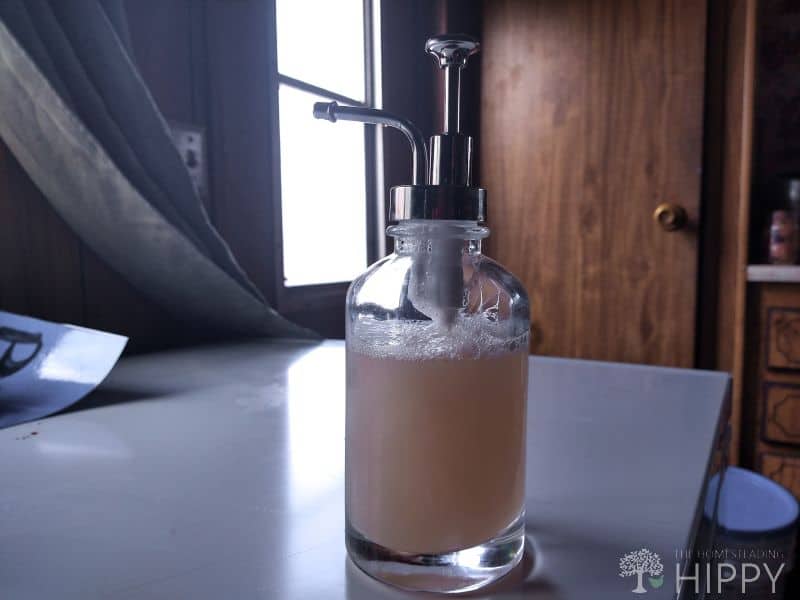
I don’t currently own a dishwasher and, unfortunately, I don’t get the feeling I will ever see one in my house.
The kitchen just wasn’t designed for that, and the amount of money it would take to update it so that I can get a working dishwasher in here, with all new plumbing that could handle it, is not a top priority financially.
So, I have to hand wash my dishes. 3 times a day, 4 days a week. My kids get the other 3 days when they don’t have school, part-time jobs, or taekwondo.
It seems like such a simple process to go out and buy dish soap for dirty dishes. But, there are always more important things to do on the homestead, so being as efficient as possible is imperative.
Washing the dishes by hand means that my hands are in the water a lot.
With the commercial dish soaps that are meant to “pull grease out of the way,” they also seem to pull grease and moisture out of my hands.
And when I am already dealing with dry skin either due to dry winter air, or being out in the dirt of the garden, having the remaining moisture pulled out of my hands isn’t fun. They can get dry, crack and bleed. Not a pretty picture.
Sure, there are lotions that I could make with DIY recipes, but it seems easier to cut out a step and create a dish soap that doesn’t harm my skin like harsh commercial products.
Running Out of Dish Soap
So, one day, while hubby and I were trying to figure out how to cut expenses from the store, I realized that we were almost out of dish soap. I hadn’t had time to get to the store, and there wasn’t much more than a sinkload of soap left.
Cutting expenses doesn’t get any easier than cutting out a purchase entirely. Now I opt to cut out commercial dish soap purchases and intend to make my own DIY liquid dish soap.
Being ME, I set out to do what I do best. Make do with what I had. I grabbed my castile soap, essential oils, and an empty hand soap bottle and began to mix it up. Make 3 ingredient dish soap without citric acid.
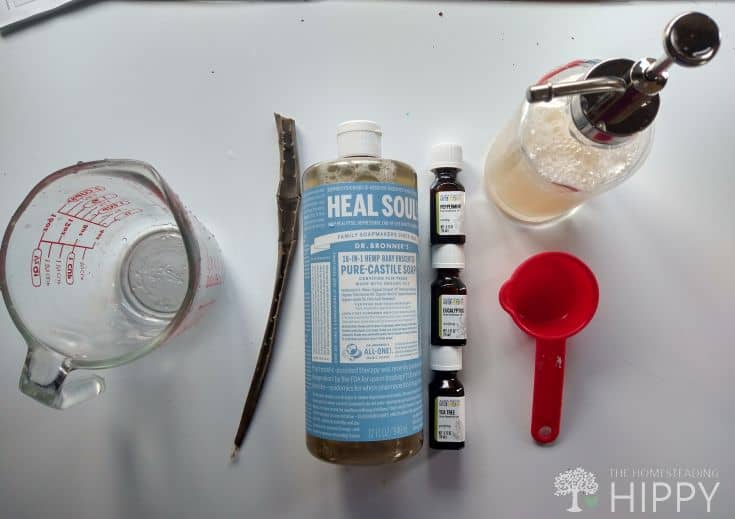
DIY Liquid Dish Soap
Equipment
- soap bottle
Materials
- 1/4 cup pure castile soap
- 3 drops essential oil Tea Tree, Peppermint, Eucalyptus
- 1 cup filtered water
- The gel from one medium size aloe vera leaf
Instructions
- To use, just swish it around, and add 5-8 squirts into a sink of hot water. This will NOT get all bubbly like “regular” dish soap, but it works very well.
Why Castile Soap?
Castile soap is the obvious choice on a homestead that values organic materials and aims to reduce water waste through greywater setups.
Castile soap is made with organic oils and, once diluted when washing dishes or any of its other uses, it is safe to use for greywater. I can use this as a base for my dish soap and use the greywater to water landscapes and trees without any harm.
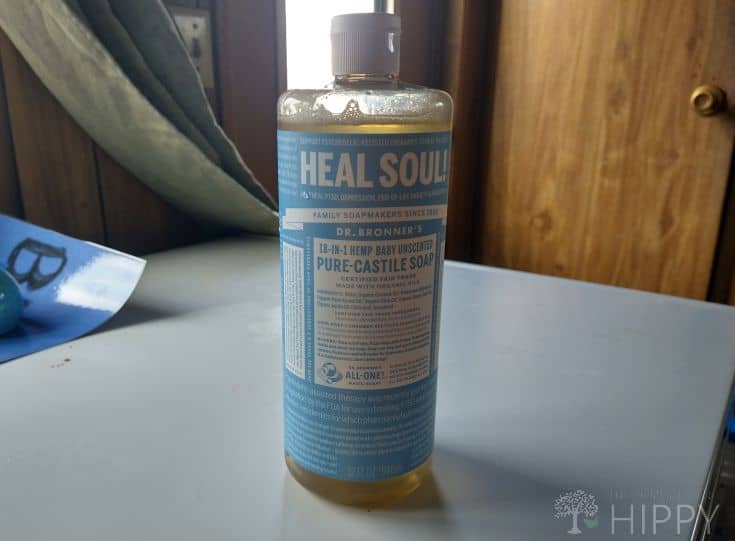
This isn’t common for commercially produced dish soaps. They have harsh ingredients that kill plant and animal life if used in greywater systems for irrigation.
The Right Essential Oils
With the hundreds of essential oils on the market, why did I choose Eucalyptus, Tea Tree, and Peppermint? They belong to the group of essential oils that are anti-bacterial. This is clearly a benefit when washing dishes and ensuring no bacteria remain on the dishes and cutlery for our next family meal.
Here is a list of the best choices of essential oils that make a good choice for your DIY liquid dish soap:
- Peppermint
- Tea Tree
- Eucalyptus
- Lemon
- Cedarwood
- Lavender
- Lemongrass
All of these will also improve the scent of your soap, which is a nice bonus. I haven’t tried combining any essential oils in my dish soap, but more adventurous homesteaders out there may try it out and let me know how it works!
Why Aloe Vera?
Aloe vera is used to promote skin integrity. If you suffer from dry hands as I do, then it’s a great addition to your soaps.
Not only that, but it is also anti-bacterial, anti-septic, anti-viral, anti-fungal, and anti-microbial. Wow, that’s a lot of punch from this little succulent!
I grow a couple of aloe vera plants on the homestead for a wide range of uses and putting a leaf’s worth of gel in each batch of dish soap is a no-brainer!
If you don’t grow your own, you can purchase pure aloe vera gel at your local health store or online. I encourage you to grow it though!
The Importance Of Water Quality
While it may seem like a small issue, the quality of the water you use to mix the soap will make or break the recipe. I used a water filter that remove all particulates and helps balance the pH towards neutral. Tap water can be full of minerals and other dissolved solids that can alter the final product.
Instead of playing the guessing game and using your tap water, it’s best to used purified water with a neutral pH for the best soap.
Final Words
Making your own DIY liquid dish soap for your homestead can just be the tip of the iceberg. Since you now have experience with castile soap, you can turn your attention to DIY recipes for hand soap, laundry soap, shampoos, conditioners, and so much more!
Making your soap is simple and cost-effective since the castile soap and essential oils stretch so far. What do you use to wash dishes?
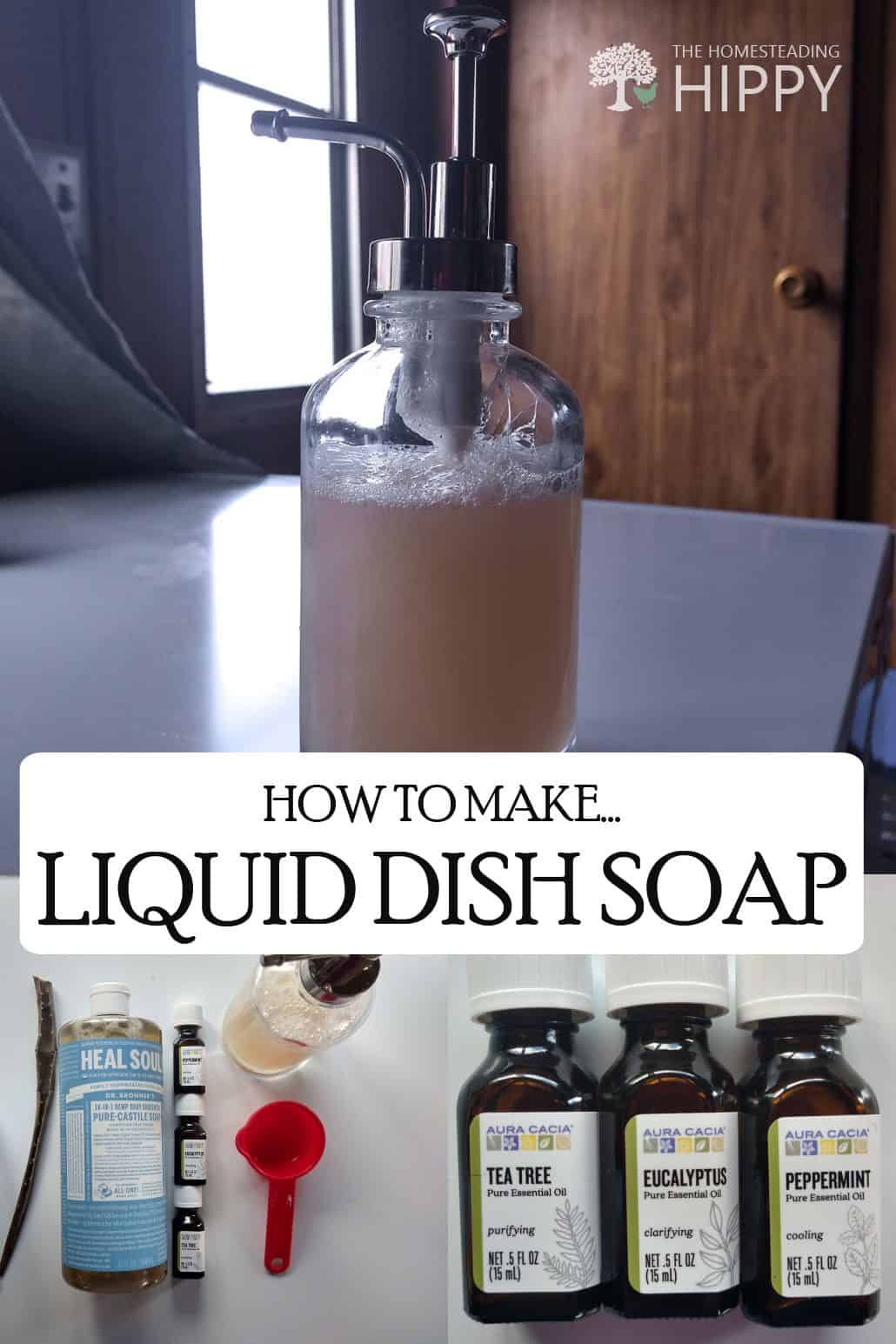

Heather’s homesteading journey started in 2006, with baby steps: first, she got a few raised beds, some chickens, and rabbits. Over the years, she amassed a wealth of homesteading knowledge, knowledge that you can find in the articles of this blog.
Learn more about Heather and the rest of the writers on this page.

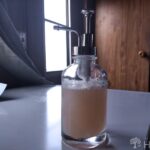
Heather,
I have been contemplating this very issue. Thanks for doing the hard work for me 🙂 I will be trying this soon.
Awesome post Heather! I’m sharing this!
I am trying go more natural in my home. This is something I will definitely be researching more. Does the Castile soap have any of the chemical ingredients that isn’t good for us.
I just ordered Castile soap on Amazon before doing my research and discovered that the brand I bought looks great originally, but when looking at the actual ingredients found it had potassium hydroxide. Did a google search on what that is exactly & this what what it said:
Potassium Hydroxide causes irritation of eyes with tearing, redness, swelling. Greater exposures cause severe burns with possible blindness resulting. Chronic Exposure: Prolonged contact with dilute solutions or dust of potassium hydroxide has a destructive effect on tissue.
Dr. Bronner’s is labeled stating +NONE REMAINS AFTER SOPONIFYING OILS INTO SOAP & GLYCERIN.